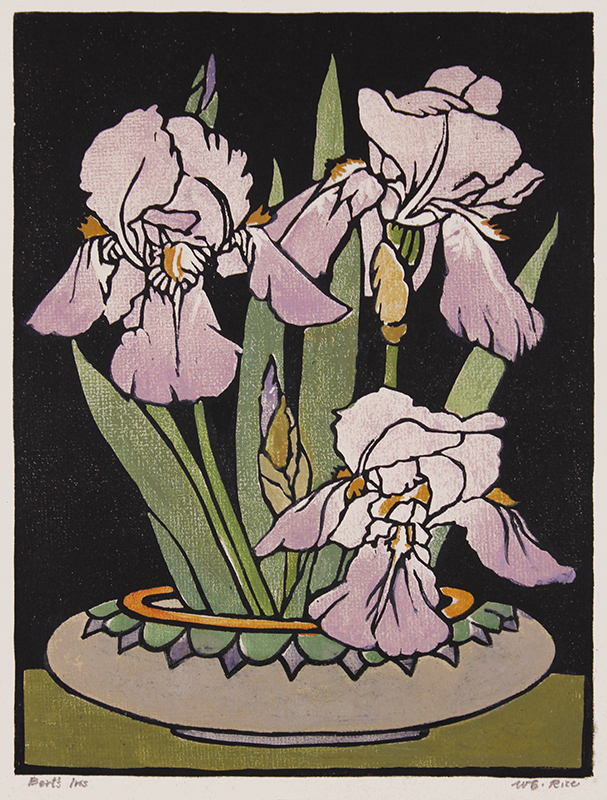
19th, 20th & 21st Century Fine Prints
707-546-7352 · fax 707-546-7924 · web: www.annexgalleries.com · email: artannex@aol.com
Bert's Iris by William Seltzer Rice

Bert's Iris
William Seltzer Rice
Bert's Iris
William Seltzer Rice
1873 - 1963 (biography)"Bert's Iris" is an exceptional example of Rice's early color woodcuts, the color applied to the blocks with brushes, like a painting. The artist would also use his fingers to apply the oil-based inks to the surface to achieve special effects, such as lighting for. The impressions of "Bert's Iris" vary dramatically from one to another, the artist had no intention of printing a formal "edition" and rarely printed more than a dozen impressions.
Rice bought his papers in San Francisco's Chinatown. It was soft and accepted ink well. He would often run the paper through the press with a piece of canvas and transfer the texture to the surface of the paper. He allowed this texture to show through as little specks of white light, as he did in the blossoms and leaves in this impression.
Ellen Treseder, in her book "William S. Rice: Art & Life", Pomegranate, 2013, discusses "Bert's Iris" on page 159: "Bert and Lizzie Fitch (Rice's sister) had a small farm outside of Stockton (CA) where they grew flowers, principally for the florists in the city. Bert did all the work himself and grew marvelous irises, zinnias, delphiniums, lilies, and other cut flowers, which sometimes appeared in Rice's watercolors and block prints; for example 'Bert's Iris'".
As an amateur botanist Rice wrote a column as such for Sunset magazine. He did a number of strong color woodcuts of floral subjects, many using the white-line method developed in Provincetown, Mass. His editions were usually under 5 impressions, never more than 15 and examples of the colors will vary from impression to impression.
William S. Rice was born in Manheim, Pennsylvania. After completing studies at the Pennsylvania School of Industrial Art and the Drexel Institute in Philadelphia, a job offer brought him to California in 1900.
At the age of twenty-seven, he accepted the position as Supervisor of Art in the Stockton Public Schools; a position he held until 1910. That same year, he moved to the San Francisco Bay Area where, for the next thirty years, Rice taught in Alameda and Oakland, as well as at the University of California Extension and the California College of Arts and Crafts where he earned his BFA in 1929.
During the 1915 Panama Pacific Exposition San Francisco, Rice had a chance to study and absorb the techniques of the Japanese woodcuts that he was to incorporate into his own working knowledge of the medium.
In 1918, the first major exhibition of his color woodcuts hung at the California Palace of the Legion of Honor. Though he gained national recognition for his printmaking, Rice embodied the Craftsman spirit, painting with watercolor and oil, and working in ceramics, hammered copper, and woodworking. He authored three books on the subject of block printing, including Block Prints: How to Make Them, and penned articles on naturalist subjects for Sunset Magazine.


